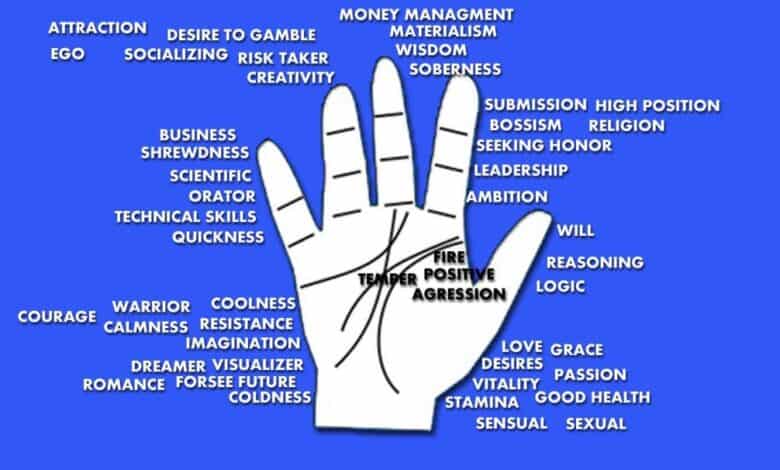A Beginner’s Guide To Palmistry
Deprecated: preg_split(): Passing null to parameter #3 ($limit) of type int is deprecated in /home/dailwtkh/public_html/wp-content/themes/jannah/framework/functions/post-functions.php on line 863

Palmistry, often known as palm reading, chiromancy, or chirology, is a fortune-telling discipline based on the study of the palm. There are several cultural variants to the practice that may be seen worldwide. Palmists, hand readers, hand analyzers, and chirologists are all terms used to describe those who perform chiromancy. Palm reading, also known as Palmistry or chiromancy, is one of the most well-known divination techniques, despite its complexity (pun intended). Palmistry is the art of interpreting personality traits and foreseeing future events by evaluating the physical aspects of the hands. Hands are seen as gateways that provide priceless information in palm reading. But, believe it or not, grasping the fundamentals of palm reading, such as the lifeline and the love line, isn’t as tough as you may think.
Though its exact beginnings are uncertain, Palmistry is said to have originated in ancient India and extended over the Eurasian landmass to China, Tibet, Persia, Egypt, and Greece. In reality, 2,500 years ago, Aristotle described palm reading in his treatise De Historia Animalium (History of Animals). “Lines are not written into the human hand without cause,” he believed.
Palmistry saw a massive rebirth in the 19th century as interest in the occult surged after falling out of favour throughout the Middle Ages. In the United Kingdom and the United States, chirological clubs were created to promote and expand the discipline; palm readers like Dublin-born William John Warner, better known by his alias, Cheiro, gathered global followings. Palmistry had been fully integrated into American Pop Culture by the mid-nineteenth century.
You can look for a great palm reader or consult astrologers in Gurgaon about it.
Which palms to read?
Though perspectives differ, many modern readers feel it is critical to examine both the left and right hands: the non-dominant hand discloses innate personality and character. In contrast, the dominant hand demonstrates how these attributes have manifested in practice. They reflect how a person is maximizing their potential in this lifetime when taken together.
Like learning to interpret an astrological birth chart, Palmistry requires time, practice, and experience to master. It’s preferable to start with the big picture and work your way down to the finer points of your study.
How to get started with Palmistry?
It’s advisable to start with bigger observations and work your way down to more intricate details while doing your investigation. Many modern readers feel it is vital to examine both the left and right hands; however, perspectives differ. The dominant hand demonstrates how these attributes have been actualized in practice, whereas the non-dominant hand reflects inherent personality and character. They reflect how a person is maximizing their potential in this lifetime when taken together.
Get to know the hand shapes that correlate to the four elements of fire, earth, air, and water. You may learn about the mountains and plains of the hand, regions that correspond to important areas of life, as well as the lines and creases that tell a tale about the future after learning hand forms and their related parts.
What are the different types of hands?
There are four main hand forms within Palmistry, each linked with a different element — fire, water, earth, and air — and its associated characteristics. Although astrology incorporates the four elements, your hand type may not match your astrological profile. While your solar sign is Aries (fire), the form of your hand might be a water sign, offering deep insight into the nuances of your nature.
What are mounts and plains?
Begin examining the natural morphology of the palm after you’ve determined the hand type. Mounts and plains, which are fleshy places, are associated with many life themes. The seven classical planets in astrology correlate to the seven classic mounts: Apollo (the sun), Luna (the moon), Mercury, Venus, Mars, Jupiter, and Saturn. Sunken mounts show an individual’s “blind spots” or undeveloped characteristics, whereas rounded, slightly raised mounts disclose balanced and well-proportioned features. Finally, conspicuous mounts indicate noteworthy features that may be overdone or overemphasized.
What do the lines on your palms signify?
The lines formed by the folds and creases of the palms are utilized to create narratives and forecast future events. The length, depth, and curvature of lines are used to establish their significance. Because no two hands are the same, keep in mind that context is essential. Are you looking for a palm reader? The best astrologer in Gurgaon can guide you in the right direction if you’re looking for a great palm reader.



